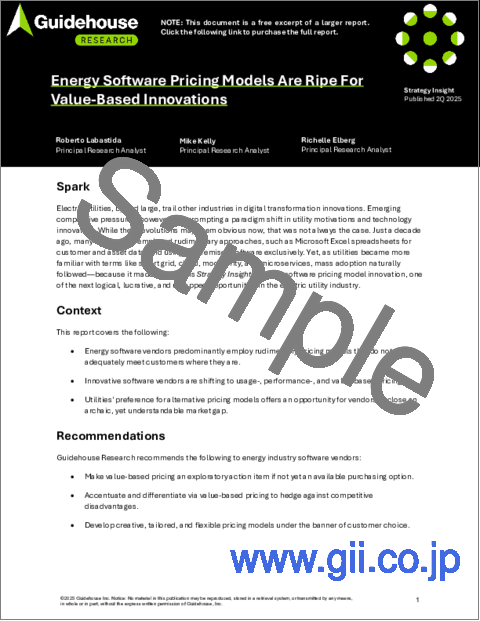|
|
市場調査レポート
商品コード
1723644
エネルギーソフトウェアの価格設定モデルは、バリューベースのイノベーションを起こす好機にあるEnergy Software Pricing Models Are Ripe For Value-Based Innovations |
||||||
|
|||||||
| エネルギーソフトウェアの価格設定モデルは、バリューベースのイノベーションを起こす好機にある |
|
出版日: 2025年05月09日
発行: Guidehouse Research
ページ情報: 英文 12 Pages
納期: 即納可能
|
全表示
- 概要
- 目次
当レポートでは、電力業界におけるソフトウェア価格設定モデルの情勢について調査し、競争力の強化と業界の進化するニーズへの対応におけるその重要性を示しています。
目次
このレポートは以下の内容を取り上げます。
- エネルギーソフトウェアベンダーの多くは原始的な価格設定モデルを採用しており、顧客の置かれている状況に適切に対応していません。
- 革新的なソフトウェアベンダーは、従量制、パフォーマンスベース、バリューベースの価格設定に移行しています。
- 電力企業の代替の価格設定モデルに対する選好は、時代遅れな、しかし理解できる市場ギャップを埋める機会をベンダーにもたらします。
This Guidehouse Research Strategy Insight explores the evolving landscape of software pricing models in the electric utility industry, underscoring their importance in enhancing competitiveness and meeting the industry's evolving needs. It highlights the shift from traditional pricing models to more innovative approaches such as usage-, performance-, and value-based pricing. The Insight emphasizes that while most energy software vendors still use rudimentary pricing models, the growing preference among utilities is for alternative pricing models that better align with their specific needs and objectives.
The Insight further provides recommendations for energy software vendors, including exploring value-based pricing and differentiating through it, as well as developing creative and flexible pricing models. It describes current energy software pricing models and examines the benefits and tradeoffs associated with different pricing approaches.
Additionally, this Insight discusses the market drivers behind recent pricing model innovations, such as evolving regulatory motivations, the need for improved customer service, and the increasing interest in flexible pricing models. It also addresses the challenges and pain points associated with software investment, including the cost and complexity of deployments, regulatory restrictions, and cybersecurity concerns.
Table of Contents
This report covers the following:
- Energy software vendors predominantly employ rudimentary pricing models that do not adequately meet customers where they are.
- Innovative software vendors are shifting to usage-, performance-, and value-based pricing.
- Utilities' preference for alternative pricing models offers an opportunity for vendors to close an archaic, yet understandable market gap.






